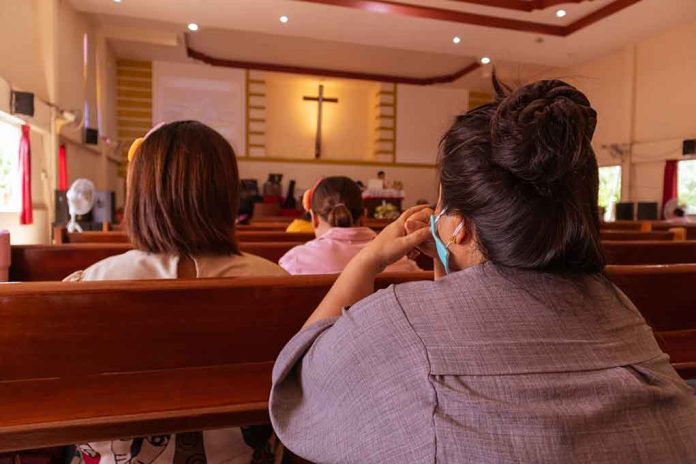
Pope Leo XIV directly challenges Pope Francis’s contentious stance on cohabitation, reaffirming the sacred nature of sacramental marriage in a powerful rebuke to progressive Catholic interpretations.
Key Takeaways
- Pope Leo XIV has called for robust evangelization of young people to promote sacramental marriage, directly contradicting Pope Francis’s previous remarks equating cohabitation to “real marriage.”
- Leo emphasized the critical importance of Catholic couples demonstrating “the truth and beauty of Christian marriage” through their lived witness to counter rising cohabitation rates.
- The Catechism #2353 explicitly describes fornication as “gravely contrary to the dignity of persons,” highlighting the doctrinal conflict with Francis’s more permissive stance.
- Studies show declining marriage rates are negatively impacting family stability, with a significant percentage of UK children not living with both natural parents by age 14.
- Pope Leo stressed the importance of sacramental grace in strengthening the matrimonial vocation, a traditional Catholic teaching that appears at odds with Francis’s more liberal position.
A Tale of Two Popes: Contrasting Views on Marriage
The Catholic Church finds itself at a theological crossroads as Pope Leo XIV’s recent statements on marriage appear to directly challenge Pope Francis’s more progressive position on cohabitation. Leo’s emphasis on the sacramental nature of marriage stands in stark contrast to Francis’s controversial 2016 remarks, where he described cohabiting couples as having “the grace of a real marriage because of their fidelity.” This theological clash highlights deeper tensions within Catholic teaching about the fundamental nature of marriage in modern society.
The divergence became particularly evident when Pope Leo XIV addressed a seminar organized by the Dicastery for Laity, Family and Life. He emphasized the need for authentic relationships and proper guidance for young people, directly countering the confusion created by Francis’s more permissive stance. While Leo didn’t explicitly name Francis, his message clearly sought to reestablish traditional Catholic teaching that has been undermined by his predecessor’s casual approach to cohabitation.
The Sacramental Essence of Marriage Under Attack
Pope Leo XIV has taken a firm stand on the sanctity of marriage, emphasizing that Catholic couples must demonstrate through their lives “what the gift of sacramental grace is and what strength derives from it.” His position reinforces the Church’s traditional teaching that marriage is not merely a social contract but a sacred covenant blessed by God. This theological foundation stands in direct opposition to the casual approach to marriage that has become increasingly prevalent in modern society and, troublingly, in some corners of Church leadership.
“Cohabiting couples can be enlightened to the truth and beauty of Christian marriage by Catholics who bear witness to the sacrament in their own lives,” said Pope Leo XIV, addressing the importance of married couples serving as examples for others.
This message contrasts sharply with Pope Francis’s 2016 statement: “I’ve seen a lot of fidelity in these cohabitations, and I am sure that this is a real marriage, they have the grace of a real marriage because of their fidelity.” Francis’s remarks have caused significant confusion among the faithful, with many conservative Catholics questioning whether such statements undermine centuries of Church teaching on the necessity of sacramental marriage. The Catechism is unambiguous, describing fornication as “gravely contrary to the dignity of persons.”
Social Consequences of Abandoning Traditional Marriage
The practical consequences of diminishing marriage’s sacramental importance are becoming increasingly evident in society. Studies cited by the Catholic Herald reveal alarming statistics: a significant percentage of children in the UK are not living with both natural parents by age 14. This social fragmentation comes as marriage rates decline and cohabitation increases, precisely the trend that Pope Leo XIV appears determined to reverse through renewed evangelization and clear teaching on marriage’s sacred nature.
“In Argentina’s northeast countryside … couples have a child and live together. They have a civil wedding when the child goes to school, and when they become grandparents they ‘get married religiously’,” Francis said, seemingly normalizing what the Church has traditionally considered sinful behavior outside the bounds of matrimony.
Cardinal Willem Eijk has noted positive reactions to marriage preparation courses, suggesting that young people are hungry for substantive teaching on marriage despite cultural pressures. Pope Leo’s emphasis on married saints like Louis and Zélie Martin and the Ulma family provides concrete examples of marriage’s sanctifying power. This approach reflects a recognition that abstract theology alone isn’t sufficient – the faithful need living witnesses to the transformative grace of sacramental marriage, especially as cultural forces increasingly undermine traditional family structures.







